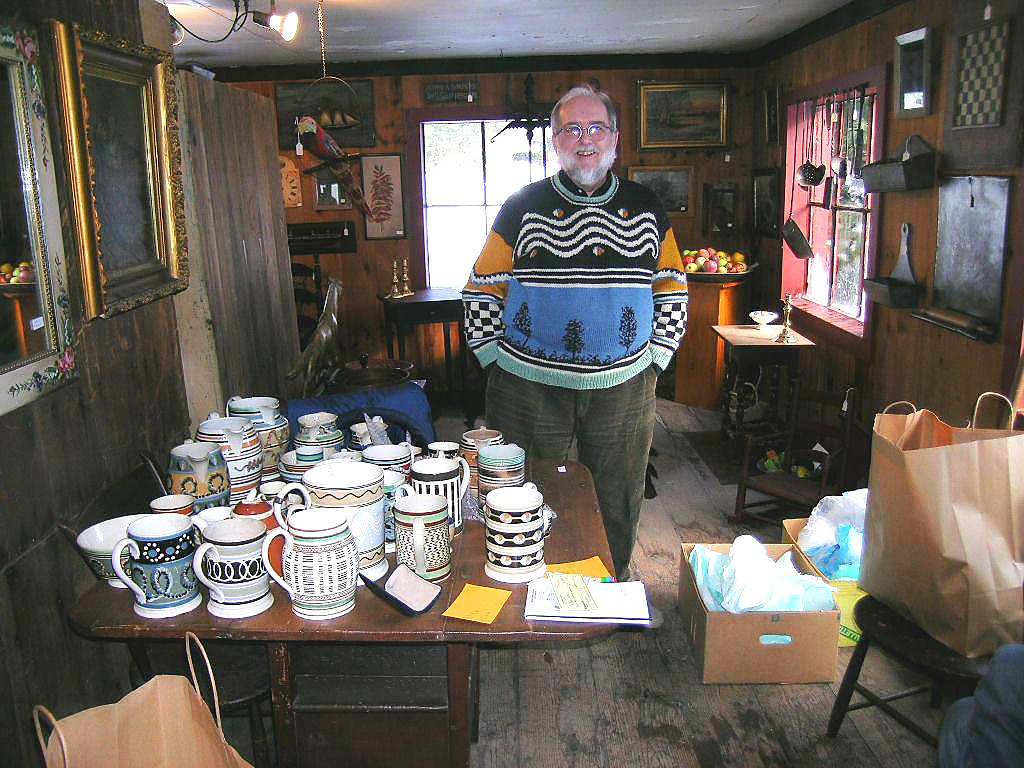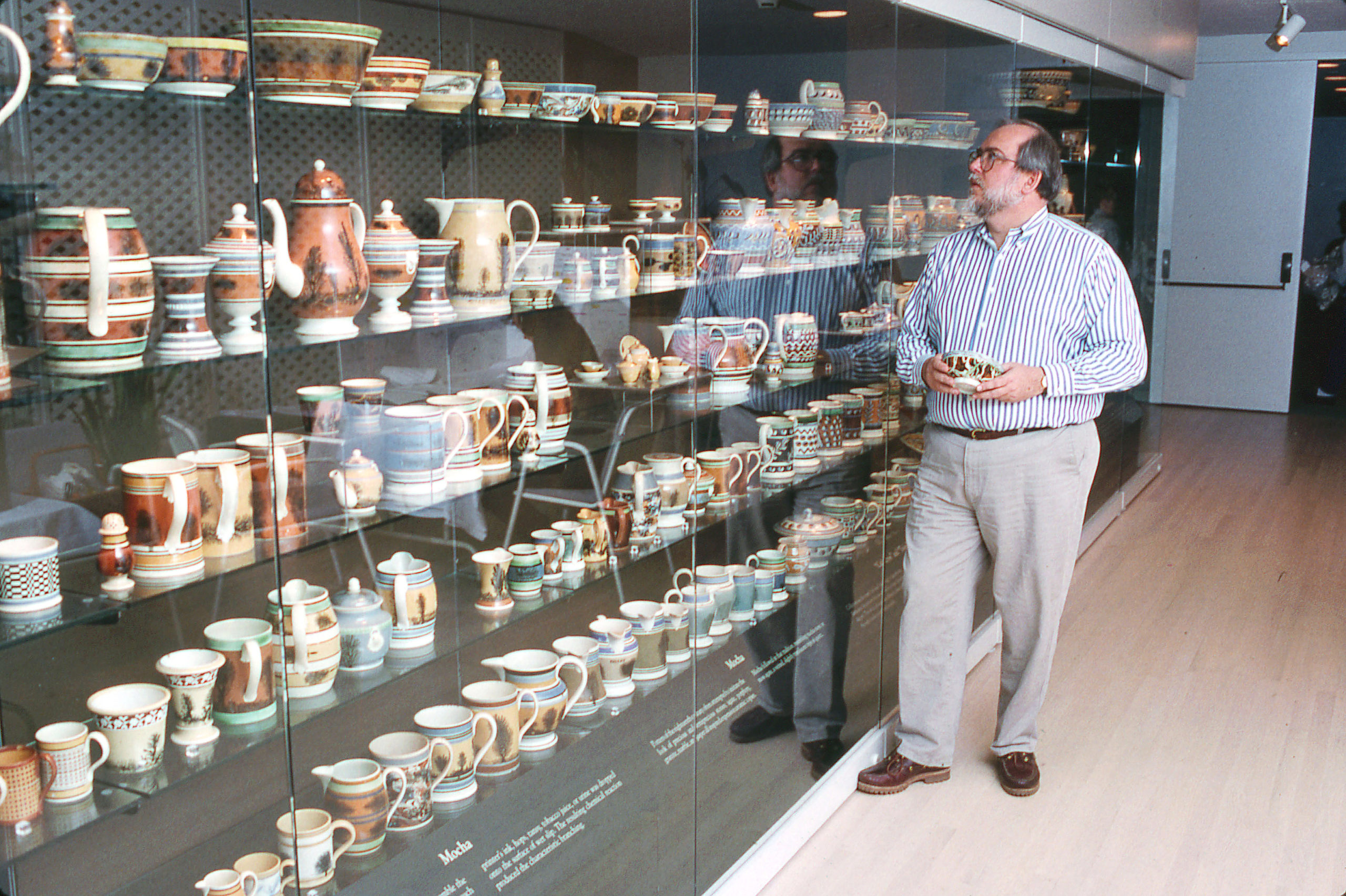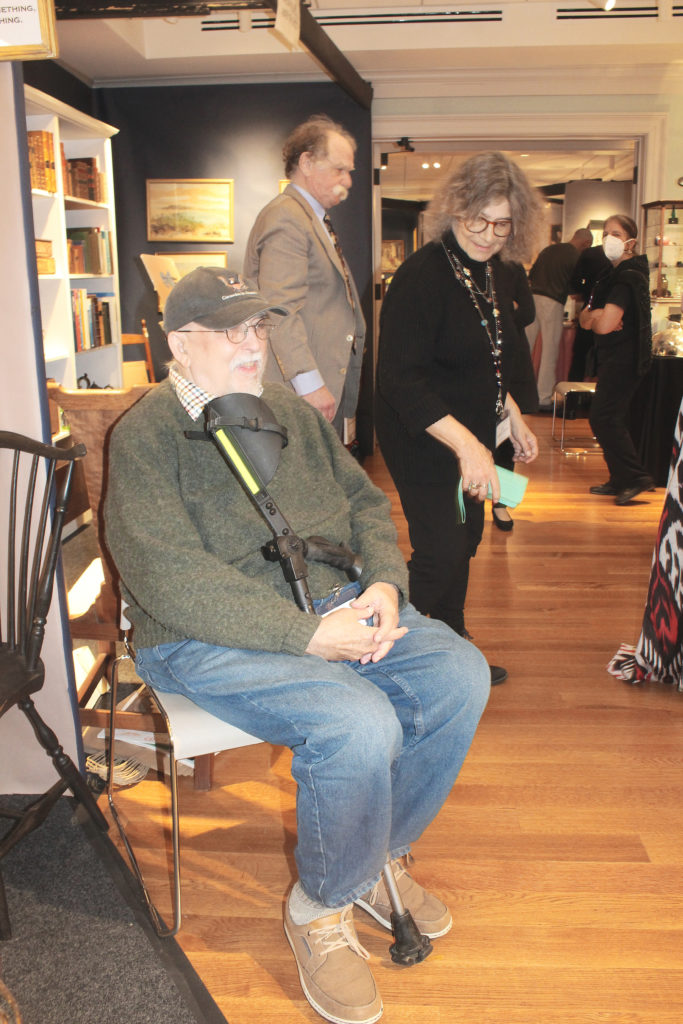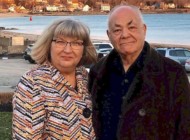
Jonathan Rickard wearing a mochaware-patterned sweater knitted for him by Joy Hanes.
DEEP RIVER, CONN. — Jonathan Shaw Rickard passed away on October 15 at his home in Deep River, Conn., at the age of 80. Born on April 4, 1942, in Attleboro, Mass., he was the son of Ruth Wheeler Rickard and Robert Hazard Rickard. As a child, he collected bottle caps and stamps; antique mechanical banks would be a later interest.
After high school, he worked in advertising and studied at the Massachusetts College of Art and Design — known familiarly as “Mass Art” — which he graduated from in 1965, having been influenced by the color studies of Joseph Albers under the tutelage of Arthur Hoener, the head of Mass Art’s graphic design program.
In an interview Jonathan gave to Joy Hanes, which was published in 2014 in the New England Antiques Journal (NEAJ), he said Hoener had studied with Albers at Yale and Hans Hoffman in Provincetown, Mass.
“From Hoener, I learned how to see. He was a proponent of Albers’ color theories, and the way one color reacts when placed against another color. Hoener’s own artwork was almost entirely in black and white. It was highly abstract and geometric, and yet he taught us to look at that and see color.”
After graduation, Jonathan continued his career in advertising, where he worked as a graphic designer and creative director, ultimately having his own ad agency in Glastonbury, Conn., retiring in his late 50s.
Jonathan’s interests eventually shifted away from mechanical banks towards slip-decorated earthenware known as mochaware, or “mocha,” a passion that sprang from an auction he attended at Skinner’s in the late 1960s. His first mochaware purchase was in 1972, a £5 pub mug he bought from a dealer in London’s Bermondsey flea market; it was followed by pieces acquired from Connecticut dealers, Orkney & Yost.
Mochaware was made in such scale, and sold for such inexpensive pieces, that it was considered commonplace; as a result, early scholarly materials were sparse. Edwin Atlee Barber’s “Mocha Ware,” published in a 1903 issue of Old China, was one of the earliest sources; it was followed by other articles in The Magazine Antiques in 1945 and 1966. But it was the first chapter in Katherine Morrison McClinton’s Antique Collecting for Everyone (1951), which was on mocha, that got Jonathan started.
Armed with some initial knowledge, Jonathan continued to buy, eventually narrowing his focus to primarily marked mochaware from the Eighteenth Century. Over time, Rickard worked in the United States with many dealers, primarily Jerome Blum, Teresa and Bill Kurau, Pam Boynton, Stephen-Douglas and William Lewan, while London dealers Garry Atkins, Charles Garland, Jonathan Horne, Alistair Sampson and John Shepherd were happy to help him grow his collection.
Jonathan’s scholarly interest in dipped wares began in 1979, stemming from his friendship with C. John Smith, a College of Art & Technology (UK) ceramics teacher. Beginning in 1986, Jonathan attended the Northern Ceramic Society’s Summer School, originally held at Keele University in Staffordshire. The program was the source not only of important friendships, but it allowed him access to archives and archaeological sites in both the United States and the United Kingdom. His friendship with Don Carpentier, a trained architect who created Eastfield Village by moving antique buildings to his upstate New York farm. By using an engine turned lathe, Carpentier was able to reproduce mocha decoration.
Smith’s pottery research was left incomplete after his death and Jonathan was prompted to pick up the torch where Smith left off. It culminated in what would become Rickard’s enduring legacy, Mocha and Related Dipped Wares, 1770-1939, which was published in 2006 by the University Press of New England in association with Historic Eastfield Foundation. It remains the definitive book on the subject and was dedicated to Jerome Blum.
According to David Barker, a senior archaeologist for the City of Stone-on-Trent, England, it was Jonathan’s incorporation of new archaeological discoveries and technical analysis on Carpentier’s practice that makes Mocha and Related Dipped Wares so important.

Jonathan Rickard, undated photo.
Jonathan contributed more than just Mocha and Related Dipped Wares to the scholarship on the topic, writing for many publications including Maine Antiques Digest, The Magazine Antiques and an article, co-authored with Don Carpentier, in the American Ceramics Circle Journal in 1997.
His most recently article, “Coincidental Attribution,” was published in Ceramics in America in 2021 but because of a delayed publication due to pandemic-related supply chain issues, Jonathan never saw it in print. It joined “Slip Decoration in the Age of Industrialization” and “The Little Engine that Could: Adaptation of the Engine-Turning Lathe in the Pottery Industry,” both also co-authored for Ceramics in America with Don Carpentier, in 2001 and 2004, respectively.
Ceramics in America editor, Rob Hunter, remembered meeting Jonathan in the late 1980s, at Colonial Williamsburg, where Hunter was assistant curator of ceramics.
“His contribution to mocha scholarship will definitely be his legacy. It was a topic that while there were a lot of collectors, the history of who made it, and when and how it was made had never been researched. He took that on.”
“He had a heart of gold. He was willing to share his knowledge with anyone who would listen. On a broader point, mochaware was the ceramics of the people. It was very inexpensive, and everyone had it; it was not an elite product. That kind of reflects Jonathan’s personality: even though he had a very high level of aesthetics, he was very humble, a people person.”

An installation view of “Mocha Mania,” the exhibition Jonathan Rickard guest curated at Colonial Williamsburg in 1993-94. Photo courtesy Colonial Williamsburg Foundation.
In addition to his writing, Jonathan promoted the scholarship with two exhibitions. He was guest curator for Colonial Williamsburg’s 1993-94 exhibition, “Mocha Mania,” and “Slipped, Dipped, Turned and Wormed” at the Brandywine River Museum in Chadds Ford, Penn., in 1995.
Janine Skerry, curator of ceramics and glass at Colonial Williamsburg from 1993-2009, who worked with Jonathan on the “Mocha Mania” exhibition, shared this memory of Jonathan:
“Jonathan was possessed of a remarkable sense of design, precision in everything he did, and a true gentleman’s graciousness. I learned this early on when I was assisting him with preparations for his ‘Mocha Mania’ exhibition at the DeWitt Wallace Decorative Arts Museum in 1993.”
“In that long-past time, much communication was done via fax. One day I received a lengthy transmission of the case-by-case installation layout for the 368 (!) objects to be featured. Each piece of mocha was hand-drawn in perfect, tiny detail, with every cat’s-eye, worm-trail and dipped balloon recreated exactly in black and white. I was filled with both awe for the verisimilitude and terror for the sheer volume packed into such shallow casework. After consulting with several museum colleagues, I telephoned Jonathan and gingerly explained that, while it was a lovely design, it was so fulsome there wasn’t an inch to spare. Would he be comfortable with editing the number of pieces while we were physically placing the ceramics? Everything couldn’t possibly fit!”
“Calmly, Jonathan assured me that everything would be fine: it would all come together exactly as planned. I started to protest, and he gamely allowed that of course objects could be deleted if needed. On the appointed date, Jonathan and the mocha arrived, and we began to install. Of course, every single piece fit just as he’d planned. Jonathan had drawn the case layouts on graph paper, with the objects rendered to scale. The faint background grid of the graph paper had not been picked up in the fax, but he knew it was correct to the inch. That was Jonathan.”
Eastfield Village ultimately became the location for seminars and workshops on early American crafts; Jonathan was instrumental in establishing there what is known as “Dish Camp,” modeled after his summer experiences in the United Kingdom. In a Q&A he gave with Antiques and The Arts Weekly in 2015, Rickard said, “I organized a three-day interdisciplinary workshop known as “Dish Camp” and devoted to ceramics made or used in America in the Eighteenth and Nineteenth Centuries. Archaeologists, curators, collectors and potters attended.”
Angelika Kuettner, associate curator of ceramics and glass at Colonial Williamsburg, was invited by Jonathan to speak at “Dish Camp” and she shared the following recollection of their relationship. “I don’t know when I first corresponded with Jonathan Rickard. My emails don’t go back far enough to encapsulate the many messages we exchanged discussing British pottery and, in particular, period terminology. But I first met him in-person about 11 years ago when he kindly invited me to participate in Historic Eastfield Village’s Dish Camp. He wrote, ‘I’m intrigued by your topic on mended ceramics and was disappointed not to make it to the Ceramics Fair in New York to hear your lecture. Will you consider giving your paper at Dish Camp?’It was an honor to accept the invitation which opened many other doors. Even though very much the new kid on the block, Jonathan always treated me as a scholar and student in the field. He encouraged all who were new to the field of British pottery, while also treating even the newest young scholars as his equals. I was privileged to know and learn from Jonathan, and I will miss him sharing his wisdom and wonderful stories through conversation, emails, articles and Facebook.”
Jonathan served on the board of the American Ceramics Circle in the late 1980s and early 1990s. Both Jonathan and Don Carpentier were recipients of an American Ceramics Circle grant that helped fund the production of their joint video on mochaware; it is still available, in two parts, on YouTube.

Jonathan Rickard at “Dish Camp’ in 2016, with Debbie Miller (left) and Melody Basolt Howarth (right). —Joy Hanes photo
Joy Hanes, one of Jonathan’s closest friends, also shared a memory of him. “I met Jonathan as a collector in the early 1980s. At that time, he was going through some upheaval, as he had recently sold his advertising agency and retired. I invited him to come with me to a meeting of my dream group, where we discussed and interpreted each other’s dreams, led by a Jungian therapist. Jonathan immediately embraced the world of dream interpretation, and we spent hours on the phone after that relaying our dreams and figuring out what they meant. I also love thinking about the years before he was stricken with MS, and we used to take long walks to the river or through a local graveyard. He was always ready to hear or tell a good joke, and he loved good food. Recently we serendipitously discovered a local pizza place that made real New Haven pizza, and I know that Jonathan returned there several times afterward. We would often go off antiquing together, and we called ourselves “partners du jour.” We were best friends.
Jonathan’s interests expanded beyond ceramics. An avid reader, he reviewed books for the New York Journal of Books, focusing on fiction, his genre-of-choice. He enjoyed cooking and landscape photography, applying tricks he learned from commercial photographers during the years he worked in the advertising business. In his NEAJ interview with Hanes, he revealed that he loved jazz and classical music, and how the Great American Songbook had been interpreted by jazz musicians. He suggested that his fondness for cars from the 1920s and ‘30s would have led to a career as an auto designer.
Hanes added, “He loved driving around New England taking pictures of buildings or scenery that he found particularly interesting. He had a connoisseur’s collection of camera equipment. His favorite pastime, after collecting, was keeping in touch with friends and collectors all over the world, and his many accolades on his Facebook page are proof of that.”

Jonathan Rickard with Joy Hanes at the preview party for the Wethersfield (Conn.) Antiques Show, November 12, 2021.
Jonathan’s brother Peter shared this tribute to him on Facebook the day he died:
“Jonathan has had so many medical maladies throughout his life that I found it a marvel that he remained so upbeat and positive. His passions for antiques, pottery and photography were his sustenance. He gave me such insight as to what it meant to be a collector; of almost everything. Jonathan will be missed by his many friends and colleagues. He had been feeling out of sorts for several days and I urged him to let me take him to the local clinic and he finally said, ‘if I’m not feeling better in the morning…’ Famous last words.”
“As children, Jonathan and I shared a bedroom with our late older brother, David, and we had a radio beside the bunk beds that ran on tubes and had a wire for an antenna and if one of us held the wire we could hear music on WARA or an occasional Red Sox night game, but Jonathan, being a Yankees fan in the 1950s wouldn’t hold the antenna for the hometown Red Sox. Always the contrarian. Goodbye Jonathan.”
Rickard is survived by Peter, who lived with him in Deep River for the last 16 months of his life; their sister, Jennifer, in Arkansas; Peter’s daughter, Bridget, in Braintree, Mass.; and other nieces and nephews in the North Attleboro, Mass., area. He was predeceased by his brother David, of North Attleboro, as well as a niece.
“Jonathan’s Last Party,” a celebration of his life and memory, will take place at 1 pm on Sunday, November 20, in the banquet hall at Clark Memorial Field (Fireman’s Field), 210 Elm Street, Old Saybrook, Conn.
In lieu of flowers, donations in Jonathan’s memory may be made to Historic Eastfield Foundation, c/o William McMillen, 3 Timber Lane, Glenmont, NY, 12077.




